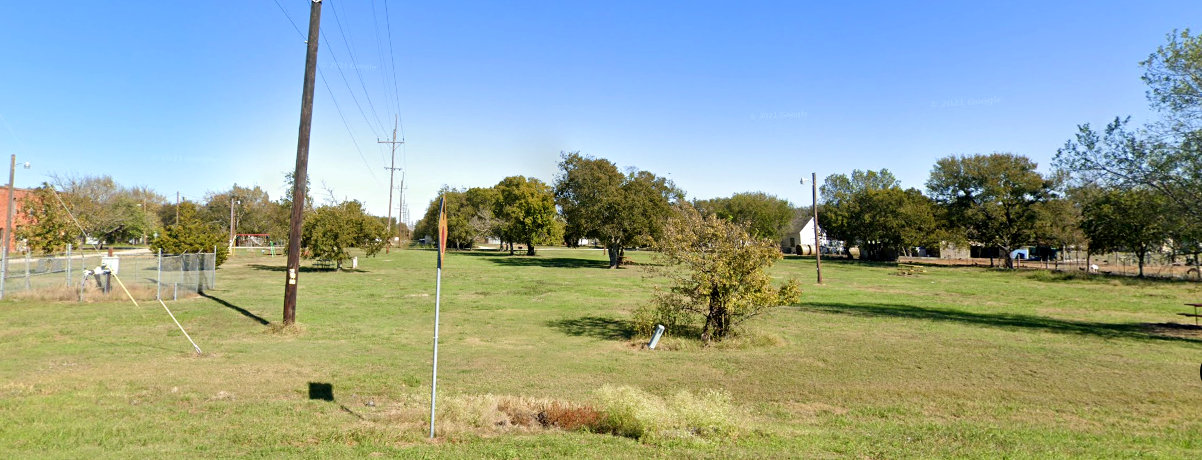Texas Railroad History - Tower 181 - Mertens
Crossing of the International & Great Northern
Railroad and the St. Louis Southwestern Railway

Above: Two railroads, the
International & Great Northern (I-GN) and the St. Louis Southwestern ("Cotton
Belt"), crossed at grade in the tiny town of Mertens, about 16 miles east of
Hillsboro. Although the crossing had existed since 1902, it remained
uncontrolled until the Tower 181 interlocker was commissioned in 1936. There was a connecting
track (blue dashed line) in the southeast quadrant of the crossing, but its
operational purpose has not been determined. All of the tracks at Mertens are abandoned: the Cotton Belt
in 1940 and the I-GN in 1967 (by that date, owned by Missouri Pacific.) Little
remains of the Cotton Belt right-of-way (ROW), but since it had telegraph lines
built along it, the ROW was also used for other utility functions (e.g. electric
power.) Hence, telltale utility poles (pink circles) remain visible in a field
east of the crossing where cultivation has otherwise removed any evidence of the Cotton
Belt grade. The I-GN ROW has survived as a mostly unpaved road running 0.4 mi.
south and 0.3 miles north from State Highway 22. In 1936, a reconstruction of
State Highway 22 produced an overpass (pink rectangle) over the I-GN tracks. The
overpass was removed in 1979, about 12 years after the I-GN tracks had been
abandoned.
According to the Handbook of
Texas, the new railroad station in Hill County that opened in 1887 near
the Navarro County line was "...called Mertens for the wife of the engineer
on the first train." Unless she was "Mrs. Mertens", this doesn't
seem particularly plausible. A more likely namesake was William Mertens, a noted railroad investor. Whatever the case, the station at Mertens
had been built by the St. Louis, Arkansas & Texas (SLA&T) Railway near property
of the first settler in the area, J. K. Walling, who had bought 135 acres of
land in 1884. As to precisely why the station was built, the answer is
undetermined; there was little population nearby, but there was an excellent
source of water at Richland Creek. The station site was apparently a good choice
because, as the Handbook of Texas explains,
Walling became very busy after the railroad's arrival.
Walling opened a general store,
acted as station agent for the railroad, and served as postmaster when Mertens
received a post office in 1888. By 1890 the community had some seventy-five
residents and a number of businesses, including physicians, carpenters, general
stores, a blacksmith shop, and a gristmill and cotton gin. In 1902 the First
State Bank of Mertens opened; it was joined by a second bank in 1910.
Mertens was about 27 miles west of Corsicana on the
SLA&T line that was completed into Hillsboro in 1888. This track was the
smallest project among a major expansion by the SLA&T throughout northeast Texas
that occurred in 1887-88, including 110 miles from Mt. Pleasant to Sherman and
97 miles from Commerce to Ft. Worth. These major construction activities coupled with
the startup expenses for operating the new lines took its financial toll,
resulting in the SLA&T entering
receivership in 1889. The SLA&T had not lasted very long, having been created only
three years earlier to acquire the assets of the Texas & St. Louis (T&SL)
Railway.
The T&SL had begun as the Tyler Tap Railroad, a company chartered in
1871 to bring rail service to the east Texas town of Tyler which had been
bypassed by two main lines. The "tap" to Tyler was finally accomplished with a
Texas & Pacific Railway connection at
Big Sandy in 1877. Two
years later, the name changed to T&SL when they built 107 miles from Big Sandy to
Texarkana along with additional tracks into Arkansas and Missouri. Westward expansion
deeper into Texas also occurred in 1880-81 including tracks from Tyler to
Corsicana (75 miles) and Corsicana to
Waco (56 miles.) By 1882, the Texas portion of the
T&SL had become profitable despite stiff competition from several railroads.
But...the expansion into Arkansas and Missouri overextended the T&SL; it lacked the lengthy sidings
and rolling stock necessary to run single-track rail lines efficiently, and it went into receivership in January, 1884.
Reorganization of the railroad's finances was slow. The bankruptcy judge
was impatient and forced the T&SL to be sold rather than merely
reorganized. Selling required dividing it into two properties, the Texas portion
and the Arkansas - Missouri portion, so that the Texas portion could be
headquartered in Texas to comply with state law regarding track ownership.
Against the advice of the Receiver, Samuel Fordyce (who predicted a
quick return to receivership), the plan was executed and the
assets of both properties were sold to a bondholders' committee in early 1886. One of the
five members of this committee was William Mertens, who might be relevant to this
story.
The bondholders' committee deeded the Texas assets to the "St.
Louis, Arkansas & Texas Railway in Texas" in February, 1886, a new company
expressly formed for the purpose of restarting the Texas portion of the
railroad. The Arkansas - Missouri assets were similarly deeded to the "St.
Louis, Arkansas & Texas Railway in Arkansas and Missouri" in April. The
management was the same for both companies, with Sam Fordyce as President. As
Fordyce had predicted during his stint as Receiver, the combined SLA&T
companies were soon unable to meet their financial obligations and they went into receivership in
May, 1889. Fordyce was again named Receiver, but with A. H. Swanson appointed to
work with him due to legal questions regarding Fordyce's eligibility to be the
Receiver for the Texas company.
History repeats itself... After a couple
of years of reorganization, another new
company, the St. Louis Southwestern Railway (eventually best known by its
nickname, the Cotton Belt) was incorporated as two corporations (one in Texas
and one in Missouri) in January, 1891. Fordyce was
again named President, but then, the receivership cycle was broken. The new enterprise was a success,
and the Cotton
Belt operated independently until 1932 when it became controlled by Southern
Pacific (SP). It continued to operate as a subsidiary corporation until it
entered voluntary receivership in December, 1935. At that time, a Trustee was
appointed to manage the railroad for the creditors. After financial
reorganization, it emerged from receivership and continued as a subsidiary of SP
until it was fully merged in 1992.
The other railroad through
Mertens was the International &
Great Northern (I-GN) Railroad, at one point the largest railroad in Texas. The
I-GN had resulted from an 1873 merger of the International Railroad with the
Houston & Great Northern Railroad. In 1901, the I-GN began to execute a plan to
assemble, through construction and acquisition, a main line between Spring (near
Houston) and Ft. Worth. The final segment to be built, from Waco to Ft. Worth,
included crossing the Cotton Belt at Mertens. The I-GN reached Mertens in July,
1902, the year after the Texas Legislature passed a law charging the
Railroad Commission of Texas (RCT) with the duty to regulate
all railroad crossings in the state (even those
that were grade separated.) The crossing of the I-GN and Cotton Belt at grade in Mertens
was uncontrolled, but neither railroad pressed the issue of implementing an
interlocker right away. Instead, to comply with state law, all trains were
required to stop before crossing the diamond. This may not have resulted in much
delay since most of the trains would be stopping at Mertens anyway.
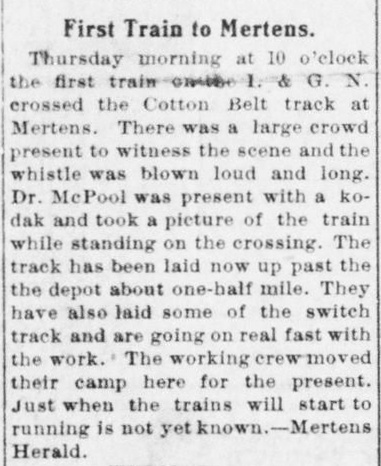 |
Left:
The Waxahachie Daily Light
carried this news story on July 4, 1902, discussing the first train to
cross the Cotton Belt at Mertens during the I-GN's northward
construction in the summer of 1902. [Note to young people: Dr McPool's "kodak"
was a popular film camera invented by George Eastman.]
Right: About four decades before
Snidely
Whiplash tied up Nell Fenwick on Canadian railroad tracks, the
Whitewright Sun of December 29,
1921 had this story about such an event in Mertens. Unfortunately, the
news article omits a critically important detail, leaving railroad
historians wondering... "Which track?" |
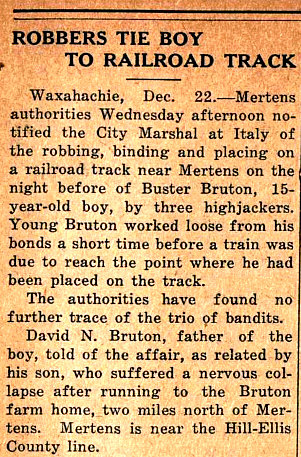 |
Right:
RCT's 1903 Annual Report (covering the 1902 calendar year) included a table of
priority rail crossings to be addressed. It did not list the five interlockers
approved in 1902; all subsequent reports listed all active interlockers by tower
number plus those "Under construction." The first column identifies the railroad
seeking the crossing, a detail omitted from all
subsequent reports. The difference in the Character of
crossing between "Grade crossing" and "Grade interlocked" is unknown.
Mertens appears in the table, implying that this new crossing (only six months
in existence) was receiving attention from RCT. Yet, the overall composition of the
table is confusing. Of the 27 interlocking towers that were soon to be commissioned
by RCT during calendar year 1903, only five made this list:
Waco, "College",
Navasota,
Texarkana and Orange
(and Bay City was early 1904.) Others on this list
were delayed for many years, e.g. Mertens (c.1936) and "Maurice"
(1929). |
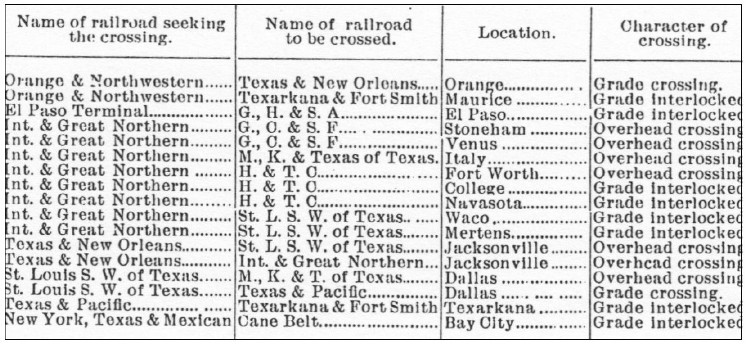 |
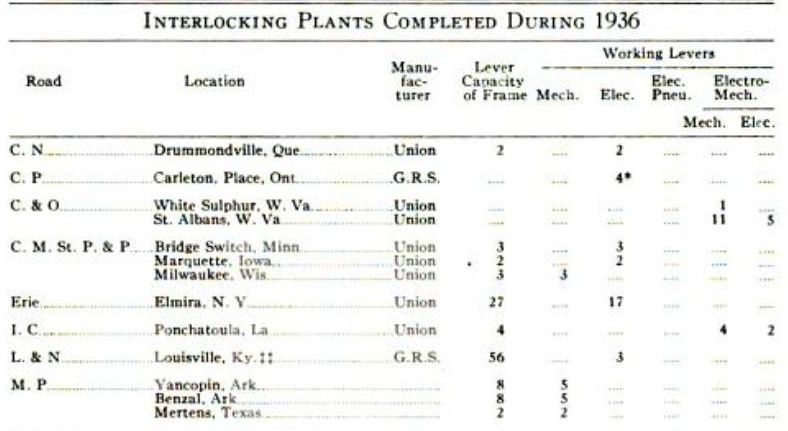 |
Left:
Railway Signaling and
Communications, in a 1938 edition, listed Mertens as a location that
received an interlocking plant in 1936. As the second railroad to arrive at Mertens, I-GN was responsible for the capital outlay for the interlocker (the
table notes I-GN's owner, Missouri Pacific, "M. P.", as the responsible
railroad.) I-GN had the busier track, so the choice of a 2-lever mechanical plant implies the
plant was to be operated by Cotton
Belt train crews. I-GN trains would always see an unrestricted "Proceed"
signal unless a Cotton Belt train had stopped to reverse the signals and
was actively crossing the diamond. The function assignment to the levers
is undetermined; levers could control more than one function. A typical
cabin interlocker without derails (which were no longer required after
1930) would have had six functions: a distant signal in each direction on
the busier line and a home signal in all four directions. But whether
this crossing was, in fact, a cabin interlocker has not been determined.
An interlocked gate could also have been used, as was the
case for the I-GN / Cotton Belt crossing in Jacksonville,
Tower 176, installed a few years earlier.
There was also a simple "ground lever" design used at
Tower 168 in West Livingston that could
have been copied for Mertens. Unlike capital expense, maintenance expenses were shared by the two railroads. An automatic
interlocker would have been more expensive to maintain, without much
benefit to the few trains operating on the Cotton Belt. A Cotton Belt or
I-GN employee timetable from 1937-1939 might help to clear up the
operational
details of Tower 181. |
Tower 181 was commissioned by RCT sometime in 1936.
Starting in 1904, RCT
had included tables of interlocker details and commissioning dates in its annual reports, but this
practice ended with the 1931 report covering calendar year 1930. Later
reports typically mentioned changes to the total interlocker count but they
did not always identify where the changes occurred. Regardless, the 1937 Annual
Report (covering 1936) has not been located. Work performed by Myron Malone
about twenty years ago at the Texas State Archives produced copies of the
interlocker sections of several post-1931 annual reports, but his effort did not
include the 1937 report.
The Cotton Belt entered voluntary
receivership in December, 1935 to restructure its finances while remaining
within the corporate umbrella of Southern Pacific. The appointed Trustee,
Berryman Henwood, managed the railroad while in receivership on behalf of the
creditors committee. In late 1938 or early 1939, Henwood submitted an
application to the Interstate Commerce Commission (ICC) requesting permission to
abandon the Hillsboro branch. A hearing was held in the spring of 1939 by an ICC
Division 4 Examiner to establish facts relevant to the decision. Five
individuals officially protested the proposed abandonment and presented evidence
at the hearing, primarily stating that the loss of the Hillsboro branch would
have a serious detrimental impact on property values and local commerce.
Among the facts
established by the Division 4 Examiner, he noted that the Cotton Belt's original rail was
still in place and badly worn after 50 years. There were 51 bridges on the
branch totaling 4,178 feet of track. Not counting the populations of the two
endpoints, Hillsboro
and Corsicana, there were about 7,000 people in the area served by this branch.
Farming was the only industry and cotton was the principal crop. Operating
statistics for the five year period 1934-1938 were examined during which the
line averaged about 100 carloads per year of local freight on the branch. There
were another 887 carloads per year of freight that either originated or
terminated (but not both) on the branch. There were also 727
carloads per year of overhead traffic, mostly interchanges with the Missouri -
Kansas - Texas ("Katy") Railroad at Hillsboro. The peak year for passenger
traffic was 1937 with 5,023 passengers, but the other years had substantially
fewer. The branch had been operating at a net deficit for at least five years;
the peak deficit was $46,684 in 1937. The Examiner noted that State Highway 22,
an "all weather" highway, paralleled the branch for its entire length. Busses
operated twice daily in each direction between Corsicana and Hillsboro, but
there were no common carrier trucks operating the route.
The final report
issued by the Division 4 Commissioners recommended approval of the abandonment
request. On January 31, 1940, the report and recommendation were submitted to the
full ICC, and on February 12, 1940, the Commission endorsed the recommendation
and granted Henwood a certificate allowing
abandonment of the Hillsboro branch. Soon thereafter, the Cotton Belt
tracks through Mertens were removed.
The I-GN tracks fared much better; Houston - Ft. Worth service via Waco continued to operate through Mertens for
nearly thirty more years. On March 1, 1956, the I-GN became fully integrated
into MP and ceased to exist as a separate corporation. In 1967, MP was able to
negotiate trackage rights on the Katy railroad between Ft. Worth and Waco. The
Katy's route was shorter than the former I-GN line through Mertens, which was
abandoned that same year.
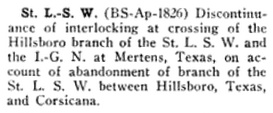 |
Left: Railway Signaling and Communications, in a
1941 issue, noted that the decommissioning of the interlocker at Mertens
had occurred.
Right:
About ten years after the former I-GN tracks through Mertens were
abandoned, the Texas Highway Commission approved a contract in June,
1978 to remove the overpass on State Highway 22 at Mertens. The bridge
over the tracks had existed since 1936. |
 |
 |
Left: This 2005 image
faces south down the former I-GN grade which has become a gravel road.
Had this photo been taken prior to 1940, the Cotton Belt diamond would
have been in the foreground.
Right: Concrete foundations, presumably for signal
posts, are the only apparent remnants near the former crossing. (Jim
King photos) |
 |
Below: Unlike the I-GN grade which ran north/south along
the eastern edge of Mertens, the Cotton Belt grade ran east/west through the
center of town. This view facing east along the Cotton Belt ROW from FM 308
shows the town park that now occupies the area south of Front St. (road at far
left.) The Cotton Belt preceded the town, hence the town built around it. The
I-GN arrived fifteen years later, by which time it was quicker and less
expensive to acquire a ROW along the edge of Mertens rather than through the
middle of it.
